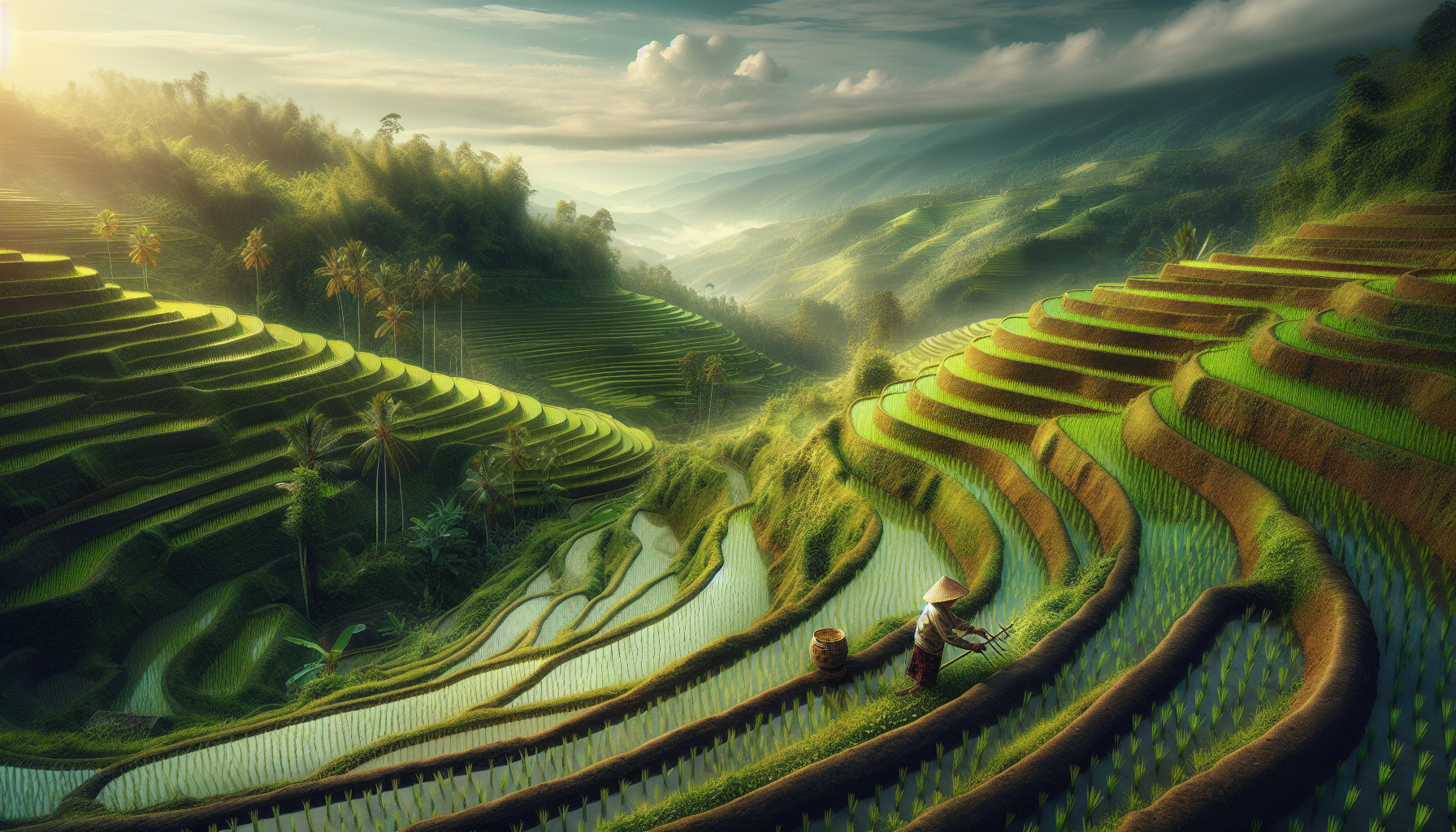In the heart of verdant landscapes where the sky kisses the earth, lies an agricultural marvel that has stood the test of time: rice terraces. These breathtaking formations, which resemble giant staircases carved into the hillsides, are more than just picturesque scenery; they are a testament to human ingenuity and the harmonious relationship between man and nature. As the sun casts its golden glow over these ancient steps, one cannot help but wonder about the secrets they hold. How did ancient farmers manage to craft such intricate systems that not only sustain their communities but also enhance the fertility of the land year after year? 🤔
The answer lies in the concept of layered cognition—a sophisticated understanding of the land’s ecology and the ability to adapt farming practices to suit its unique characteristics. This article will take you on an enlightening journey through the history and science behind rice terraces, exploring how these ancient techniques continue to play a crucial role in modern agriculture. We will delve into the symbiotic relationship between water management, soil preservation, and crop productivity, revealing how these interconnected elements contribute to enhanced yields and sustainability. Along the way, we’ll uncover the wisdom embedded in these practices, offering insights into how they can be adapted and applied in today’s world to tackle pressing issues such as food security and environmental conservation.
Join us as we unravel the layers of knowledge embedded in rice terraces, shedding light on the intricate dance between tradition and innovation. From the mountains of the Philippines to the valleys of China, we’ll traverse the globe to witness the enduring legacy of these agricultural wonders. Through this exploration, you’ll gain a deeper appreciation for the profound understanding of natural systems that ancient farmers possessed and learn how these insights can inspire more sustainable and resilient farming practices today. 🌾 Whether you’re a seasoned agriculturist, a sustainability enthusiast, or simply curious about the marvels of the natural world, this article promises to enrich your perspective and ignite your imagination.
The Intricate Design of Rice Terraces
Rice terraces are one of the most fascinating agricultural landscapes in the world, characterized by their tiered slopes that hug mountainous terrains. These terraces are not only a testament to human ingenuity but also embody a deep understanding of ecology and sustainable farming practices. Originating in ancient times, these terraces can be found across Asia, with notable examples in the Philippines, China, and Indonesia.
The intricate design of rice terraces is primarily motivated by the need to adapt to challenging environments where traditional farming methods would be inefficient or impossible. By carving steps into the hillsides, ancient farmers were able to maximize arable land area while simultaneously implementing natural irrigation systems. This method ensures water flows consistently across each tier, optimizing growth conditions for rice—a water-intensive crop.
To fully appreciate the ingenuity behind these terraces, it’s crucial to consider their environmental and economic impacts. Rice terraces contribute to biodiversity conservation, erosion control, and water management, making them an essential part of sustainable agriculture. Their aesthetic beauty and cultural significance also attract tourism, providing economic benefits to local communities. Let’s delve deeper into how these structures enhance crop yields and sustainability.
The Engineering Behind Terraces
Designing and maintaining rice terraces require profound engineering skills. The process begins with selecting an appropriate site, typically on a slope with access to a reliable water source. Farmers then carve horizontal steps into the hillside, using stones, mud, or both to create retaining walls that hold the soil in place. This practice prevents soil erosion and maintains soil fertility, critical for sustaining crop yields.
Each terrace is designed with a slight gradient, ensuring that water flows gently from one tier to the next. This natural irrigation system not only conserves water but also allows for the even distribution of nutrients, crucial for rice growth. Moreover, the terraces act as natural flood control systems, mitigating the impact of heavy rains by allowing excess water to drain off gradually.
Maintenance of the terraces is a continuous process, involving regular checks and repairs of the retaining walls and irrigation channels. This work is often a communal effort, emphasizing the social and cultural importance of terraces in local communities. The shared responsibility in terrace maintenance fosters a sense of community and reinforces traditional knowledge, ensuring that these ancient techniques are passed down through generations.
Ecological Benefits and Biodiversity
Rice terraces provide numerous ecological benefits that enhance their sustainability. The terraces create unique microenvironments that support a diverse range of plant and animal life. The standing water in the terraces serves as a habitat for aquatic organisms such as frogs and fish, while the surrounding areas support various terrestrial species.
By providing habitats for different species, rice terraces contribute to biodiversity conservation, which is essential for the resilience of ecosystems. Biodiversity enhances ecosystem productivity and stability, ensuring that ecological processes such as pollination, nutrient cycling, and pest control function effectively.
The terraces also help to maintain soil health, a crucial factor in sustainable agriculture. The controlled water flow prevents soil erosion and promotes the deposition of nutrient-rich sediments, enriching the soil and enhancing its fertility. This natural fertilization process reduces the need for chemical fertilizers, lowering the environmental impact of rice cultivation.
Water Management and Climate Adaptation
Water management is a key aspect of rice terrace sustainability. The terraces are designed to maximize water efficiency, capturing rainfall and channeling it through a series of interconnected ponds and channels. This system not only conserves water but also provides a buffer against droughts, ensuring that rice crops receive adequate water supply even in dry seasons.
The ability of rice terraces to regulate water also plays a significant role in climate adaptation. As climate change leads to more extreme weather patterns, including increased rainfall and prolonged dry spells, the terraces’ natural irrigation systems provide resilience against these challenges. By maintaining stable growing conditions, rice terraces contribute to food security in the face of climate variability.
Watch the video below to see the stunning engineering of rice terraces in action: Rice Terraces: Engineering Wonders of Ancient Times
Socioeconomic Impact and Cultural Significance
The socioeconomic impact of rice terraces extends beyond their agricultural benefits. These terraces are integral to the cultural identity of the communities that maintain them, representing a way of life that has been preserved for centuries. The knowledge and skills required to create and sustain these terraces are passed down through generations, ensuring their continued relevance.
Rice terraces also contribute to the local economy through tourism. The breathtaking landscapes attract visitors from around the world, providing income opportunities for local residents. Tourists are drawn not only to the beauty of the terraces but also to the rich cultural heritage of the communities that cultivate them.
In addition to tourism, rice terraces support local economies through agriculture. The terraces enable the cultivation of rice, a staple food for millions of people, providing a stable food source and contributing to food security. The economic benefits of rice terraces are thus multifaceted, supporting livelihoods while preserving cultural heritage.
Challenges and Future Prospects
Despite their many benefits, rice terraces face several challenges that threaten their sustainability. Urbanization and land use changes pose significant risks, as they can lead to the abandonment of terraces and the loss of traditional knowledge. Furthermore, climate change presents new challenges, with shifting weather patterns affecting water availability and crop yields.
Addressing these challenges requires a collaborative effort involving local communities, governments, and international organizations. Initiatives to promote sustainable land management practices, enhance climate resilience, and preserve cultural heritage are essential for the future of rice terraces. By supporting these efforts, we can ensure that these ancient farming techniques continue to benefit future generations.
Explore the table below to compare the key features and benefits of rice terraces across different regions:
| Region | Key Features | Benefits |
|---|---|---|
| Philippines | Stone and mud retaining walls, communal maintenance | Biodiversity, water conservation, tourism |
| China | Complex irrigation systems, diverse cropping patterns | Food security, cultural preservation, climate adaptation |
| Indonesia | Rich cultural heritage, diverse ecosystems | Economic opportunities, soil fertility, resilience to climate change |
The table above highlights the diverse features and benefits of rice terraces in different regions, emphasizing their importance for sustainable agriculture and cultural preservation. To learn more about how these terraces contribute to local economies and ecosystems, dive deeper into the stories of the communities that sustain them.
- Learn how the ancient engineering of rice terraces continues to inspire modern sustainable practices.
- Discover the cultural traditions and communal efforts that maintain these awe-inspiring landscapes.
- Explore the future prospects for rice terraces in the face of climate change and urbanization.
By understanding and appreciating the secrets of layered cognition in rice terraces, we can draw valuable lessons for sustainable agriculture worldwide. 🌾

Conclusion
Conclusion
In exploring the profound topic of layered cognition in rice terraces, we have delved into the rich history and advanced understanding of ancient farming techniques that have stood the test of time. These intricate systems, primarily developed by indigenous communities, offer valuable insights into sustainable agriculture and enhanced crop yields. The genius of these ancient practices lies in their harmonious integration with the natural environment, maximizing efficiency and productivity while minimizing ecological impact.
Throughout this article, we’ve examined how these terraces operate as complex, multi-layered systems, incorporating water management, soil conservation, and biodiversity. These components work together to create a self-sustaining agricultural model that supports high crop yields and environmental resilience. We’ve also discussed how the topography of rice terraces aids in preventing soil erosion and maintaining soil fertility through natural nutrient cycles. This approach not only enhances crop yields but also contributes significantly to the local ecosystem’s health.
Moreover, the cultural significance of rice terraces cannot be overstated. These landscapes represent a symbiotic relationship between humans and nature, underscoring the importance of respecting and preserving traditional knowledge. The terraces are a testament to human ingenuity and adaptability, embodying lessons that are increasingly relevant in today’s quest for sustainable agricultural practices.
In an era where modern agricultural practices often lead to environmental degradation and resource depletion, the wisdom encapsulated in these ancient systems offers a path forward. By adopting and adapting these traditional techniques, we can address some of the critical challenges facing agriculture today, such as climate change, soil degradation, and food security.
The exploration of layered cognition in rice terraces highlights the necessity of integrating traditional knowledge with modern innovations. This integration can lead to the development of more sustainable and resilient agricultural practices that benefit both the environment and the communities that depend on it. As we continue to face global agricultural challenges, these ancient techniques remind us of the importance of looking to the past to inform our future.
We invite you to reflect on the valuable lessons these ancient systems offer and consider how they can be applied in contemporary contexts. By sharing this knowledge and engaging in discussions about sustainable agriculture, we can contribute to a more sustainable and equitable future. 🌾
We encourage you to share your thoughts and insights on this topic in the comments section below. How do you see the integration of traditional farming techniques with modern practices? Have you encountered similar sustainable practices in other agricultural systems? Let’s continue this important conversation and inspire positive change in the way we approach agriculture and sustainability. Feel free to share this article with others who might be interested in uncovering the secrets of layered cognition in rice terraces and join us in spreading awareness about the importance of sustainable farming practices.
For further reading and exploration, consider checking out resources like the International Rice Research Institute (IRRI) https://www.irri.org and the Food and Agriculture Organization of the United Nations (FAO) http://www.fao.org, which offer a wealth of information on sustainable agriculture and the role of traditional farming techniques in modern contexts. By continuing to educate ourselves and others, we can work towards a more sustainable future for generations to come.
Toni Santos is a visual storyteller and cognitive explorer whose work delves into the mental landscapes of ancient cultures—revealing how different civilizations perceived reality, memory, and meaning long before modern psychology existed. Through symbolic imagery and narrative inquiry, Toni brings to life the divergent ways of thinking that shaped lost worlds.
His creative path is guided by a fascination with non-linear logic, oral cosmologies, and the mythic frameworks that once guided decision-making, emotion, and identity. From memory temples carved in stone to visual languages encoded in textiles, every piece Toni creates reflects the vast cognitive diversity of the human story.
With a foundation in visual design and cultural semiotics, Toni blends analytical depth with artistic expression. His work goes beyond historical reconstruction—it reawakens the embodied, intuitive, and ritual-based intelligence of ancient minds, inviting us to question the assumptions of modern thought.
As the mind behind Vizovex, Toni curates visual studies, essays, and immersive content that explore forgotten epistemologies—ways of knowing that connected people to myth, land, and each other in profoundly different ways.
His work is a tribute to:
The symbolic intelligence of pre-modern cultures
The neural diversity embedded in ancient rituals and storytelling
The deep memory systems that shaped identity and perception
Whether you’re a researcher, an artist, or a seeker of hidden wisdom, Toni invites you to enter a space where cognition is culture, and where the past speaks through signs, cycles, and symbols—one myth, one memory, one mind at a time.





